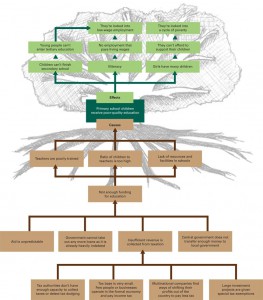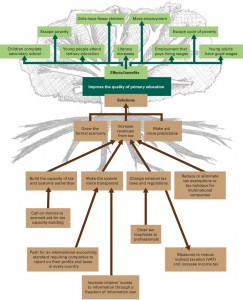Think about the problem and its causes
The first step before any strategy development or advocacy intervention is to identify the problem and its underlying causes. Only through analysing the causes of the problem will you be able to see which interventions or advocacy strategies will be most appropriate to tackling it. The underlying issue (or cause) may not be obvious and you
may need several approaches to understand the problem, including participatory exercises involving affected community members, desk-based research or interviews.
Chapter 1 identified a number of problems and underlying causes related to tax. It also showed how advocacy that addresses these causes can make a real difference. For example:
- Inadequate essential services, such as health services or education, are a major problem contributing to poverty. Lack of domestic revenue through tax to pay for services is one of the underlying causes. Successful citizens’ campaigns in Bolivia led to the government introducing new taxes on mining companies and using these revenues for education and pensions.
- Governments are often insufficiently accountable to their citizens. One of the causes is that governments are more dependent on aid than on domestic tax revenues and therefore their greatest accountability is towards donors. Domestic revenue mobilisation is part of the answer, as tax revenues have been shown to increase governments’ accountability to their citizens. Advocacy by civil society in countries including Ghana, India, the Philippines and Brazil has therefore sought to influence governments to adopt fair, transparent taxation policies that can be monitored by the people.
Two tools are presented in this section: the ‘But why?’ technique, and problem and solution trees. They are designed to help you focus on the causes instead of the symptoms of the problem. Identifying genuine solutions to a problem requires knowing what the real causes of the problem are. Taking action without identifying what factors contribute to the problem can result in misdirected efforts. This wastes time and resources.
Many causes and solutions may apply to your problem, so it is up to you to find the ones that seem most important and that your organisation has the capacity to work with.
TOOL‘But why?’2
The ‘But why?’ technique examines a problem by asking questions to find out what caused it. Each time an answer is given, a follow-up ‘But why?’ is asked.For example, if you say that people in poor communities don’t have access to clean drinking water, you may ask yourself ‘But why?’ Once you come up with an answer to that question, probe the answer with another ‘But why?’ question, until you reach the root cause of the problem.
For example, does the problem start with lack of hygiene education, resulting in people not caring about clean water, or is it because they don’t know how to dig safe drinking water wells? Or is it a result of government’s failure to implement well-digging programmes? If it is a result of government failure, why is this happening? Is it because of a lack of money? Why is there a lack of money for drinking water wells? Is the government inefficient at collecting taxes? Are the taxes misspent?
How does the ‘But why?’ technique work?
The immediate problem
Children are not going to school
Ask why?
They keep falling ill
Possible response:
Provide medicines
Ask why?
They drink bad water
Possible response:
Dig a well
Ask why?
The well is too far from the school
Possible response:
Put in a pipe
The local government said it would dig a new well last year but it hasn’t
Possible response:
Dig a well or lobby local government to provide the well
Ask why?
Central government has not released the funds it promised
Possible response: Dig a well or put in a pipe, or lobby central government to release the funds
Ask why?
The government did not collect sufficient taxes
Dig a well or put in a pipe, or lobby central government to collect the taxes and disperse them more speedily or to prioritise collecting tax from businesses that are dodging them
Ask why?
The government struggled to stop businesses dodging tax
Possible response: Campaign for an end to tax havens so it’s harder for money that should be paid in taxes to be hidden from the government
TOOLProblem and solution trees
Problem and solution trees are a good way of analysing an issue and can be easily used in a group.The problem tree enables you to identify the root causes and main effects of the problem. By then using a solution tree, you can turn the problem into a positive goal for your advocacy, the root causes into possible solutions, and the effects into potential benefits. For detailed instructions on how to use problem and solution trees, see Exercise 2 in the interaction pages at the end of this chapter.
Here is an example of a problem tree focusing on tax-related problems:
Here is an example of a solution tree focusing on tax-related problems:
The problem tree exercise may throw up multiple root causes of a problem. Prioritisation is therefore important so you don’t overstretch yourselves and risk being ineffective.
Here’s a useful list of questions to help identify which issue to prioritise.3
Will working on the issue:
- result in real improvement in people’s lives?
- give people a sense of their own power?
- be widely and deeply felt?
- build lasting organisations and alliances?
- provide opportunities for women and others to learn about, and be involved in, politics?
- develop new leaders?
- promote awareness of, and respect for, rights?
- link local concerns with larger-scale, even global, issues?
- provide potential for raising funds?
- enable the organisation to further its vision and mission?
- be winnable? Does it have a clear target, time frame and policy solution?
Do some research and analysis
After your initial problem analysis, further research will be needed to:
- provide credible evidence for your arguments. Policy-makers are unlikely to be convinced by your analysis of the problem and the solutions unless you have well-researched evidence to support your analysis. Researching tax issues can be particularly challenging, which is why we have devoted a separate chapter (Chapter 3)providing useful tips and tools on how to research tax issues
- justify a particular course of action to your organisation and partners
- find facts and stories to illustrate your issue. These are important to explain and persuade both policy-makers and your potential supporters of your case.

